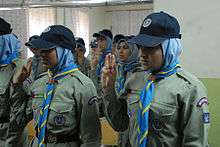Education in Afghanistan
Education in Afghanistan includes K–12 and higher education, which is greatly supervised by the Ministry of Education and Ministry of Higher Education in Kabul, Afghanistan.[1] Afghanistan is going through a nationwide rebuilding process and, despite setbacks, institutions are established across the country. By 2013 there were 10.5 million students attending schools in Afghanistan,[2] a country with a population of around 35.5 million people.[3]

History
One of the oldest schools in Afghanistan is the Habibia High School in Kabul, which was built by King Habibullah Khan in 1903 to educate students from the nation's elite class. In the 1920s, the German-funded Amani High School opened in Kabul, and about a decade later two French lycées (secondary schools) began, the AEFE and the Lycée Esteqlal. The Kabul University was established in 1932.
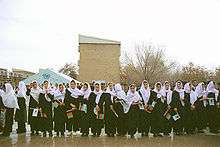
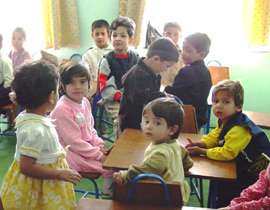
Education was improved under the rule of King Zahir Shah between 1933 and 1973,[4] making primary schools available to about half the population who were younger than 12 years of age and expanding the secondary school system and Kabul University.
During the Democratic Republic of Afghanistan, the government of the People's Democratic Party of Afghanistan (PDPA) reformed the education system; education was stressed for both sexes, and widespread literacy programmes were set up.[5] By 1978, women made up 40 percent of the doctors and 60 percent of the teachers at Kabul University; 440,000 female students were enrolled in educational institutions and 80,000 more in literacy programs.[6] Despite improvements, a large percentage of the population remained illiterate.[4] Beginning with the Soviet invasion of Afghanistan in 1979, successive wars virtually destroyed the nation's education system.[4] Most teachers fled during the wars to neighboring countries.[4] In the middle of the 1990s, about 650 schools were destroyed or used as bunkers. In 1996 the Taliban regime restricted education for females, and the madrassa (mosque school) became the main source of primary and secondary education. About 1.2 million students were enrolled in schools during the period of Taliban rule, with fewer than 50,000 of them girls.[7]
After the overthrow of the Taliban in late 2001, the Karzai administration received substantial international aid to restore the education system. Around 7,000 schools were operating in 20 of the 32 provinces by the end of 2003, with 27,000 teachers teaching 4.2 million children (including 1.2 million girls).[4] Of that number, about 3.9 million were in primary schools.[4] An estimated 57 percent of men and 86 percent of women were reported to be illiterate, and the lack of skilled and educated workers was a major economic disadvantage.[4] When Kabul University reopened in 2002, some 24,000 male and female students enrolled for higher education.[4] In the meantime, five other universities were being rehabilitated. Public school curricula have included religious subjects but detailed instruction is left to religious teachers.[4]


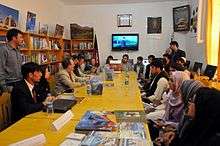
By 2006, over 4 million male and female students were enrolled in schools throughout Afghanistan. At the same time school facilities or institutions were also being refurbished or improved, with more modern-style schools being built each year. The American University of Afghanistan (AUAF) in Kabul was established in 2006. Other universities were renovated or rebuilt, such as Kandahar University in the south, Nangarhar University and Khost University in the east, Herat University in the west and Balkh University in the north. Despite these achievements, there were still significant obstacles to education in Afghanistan, many of which stem from a lack of funding. Planning curricula and school programs is difficult for the Ministry of Education because a significant amount of the budget for education comes from external donors, making it difficult to predict the annual budget.[8]
The obstacles to education were even more numerous for Afghan girls. Afghanistan's then Education Minister, Mohammad Hanif Atmar, said in 2007 that 60% of students were studying in tents or other unprotected structures, and some parents refused to let their daughters attend schools in such conditions.[8] A lack of women teachers was another issue that concerned some parents, especially in more conservative areas. Some parents were not allowing their daughters to be taught by men. But this often meant that girls were not allowed to attend school, as the international aid agency Oxfam reported in 2007 that about one quarter of Afghan teachers were women.[8] In 2009, another concern was the destruction of schools by the Taliban, especially schools for females. Following the destruction of over 150 schools in a year, many parents had doubts about the government's ability to protect them.[9]
The following achievements were made in the first decade of the 2000s:
- Between 2001 and 2016, primary school enrolment rose from around 1 million to 9.2 million (a ninefold increase in fifteen years) and the proportion of girls from virtually zero to 37%.
- The number of teachers in general education has risen sevenfold, but their qualifications are low. About 31% are women.
- Since 2003 until 2010, over 5,000 school buildings have been rehabilitated or newly constructed. Just over 50% of schools have usable buildings.
Enrollment is low: The average is 1,983 students per institution; three institutions have fewer than 200 students. Furthermore, there is a deficiency of qualified faculty members: only 4.7% (166 of total 3,522) of the teaching staff held a Ph.D. In “addition to problems of inadequate resources, and lack of qualified teaching staff are issues of corruption.”[10]
In 2010, the United States began establishing Lincoln Learning Centers in Afghanistan. They serve as programming platforms offering English language classes, library facilities, programming venues, Internet connectivity, educational and other counseling services. A goal of the program is to reach at least 4,000 Afghan citizens per month per location.[11][12][13]
According to the Human Development Index, in 2011, Afghanistan was the 15th least developed country in the world.
In 2009 and 2010, a 5,000 OLPC – One Laptop Per Child schools deployment took place in Kandahar with funding from an anonymous foundation.[14] The OLPC team seeks local support to undertake larger deployment.[15][16]
In June 2011, officials from the United States signed a joint statement with Education Minister Ghulam Farooq Wardak to expand opportunities for direct financial support from USAID to the Afghan Ministry of Education.[17] In December 2011, the Baghch-e-Simsim (Afghan version of Sesame Street) children's television series was launched in Afghanistan. It is funded by the U.S. Department of State and is produced in consultation with Afghanistan's Ministry of Education. The project is designed to help educate Afghans from pre-school stage and onward.[18]
It was reported in May 2013 that there were 16,000 schools across Afghanistan, with 10.5 million students. Education Minister Wardak stated that 3 million children remained deprived of education and requested $3 billion to construct 8,000 additional schools over next two years.[2]
Afghanistan’s story in education is still confronted by major challenges. Three and a half million children – 75% of them girls – are still out of school. Poverty, the lack of qualified female teachers in rural schools (which is especially linked to girls' education), and substandard school facilities all account for low enrollment. Furthermore, nearly half of all schools do not have a building or facilities.
In 2015 at Kabul University the first master's degree course in gender and women’s studies in Afghanistan began.[19]
Challenges to education development
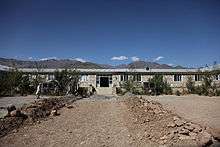
Violence
Afghanistan is one of the countries worst affected by violence against schools, with 770 incidents of attacks on education in 2008. Violence against students prevented nearly 5 million Afghan children from attending school in 2010. Afghanistan saw 439 teachers, education employees and students killed in 2006-9, one of the highest death rates in the world.[20]
Teacher credentials
Since the Taliban regime was toppled in 2001, up to 6 million girls and boys started attending school. In 2012, the supply of students far exceeded the pool of qualified teachers.[21] According to statistics provided by the Ministry of Education, 80 percent of the country’s 165,000 teachers had achieved the equivalent of a high school education or did not complete their post-secondary studies.[21]
Curriculum
Since the toppling of the Taliban regime, under the combined efforts of Afghan and international experts, the curriculum has been changed from Islamic teachings; there are new books and better training. Yet, there remains no standard curriculum for secondary school textbooks, and high school textbooks remain woefully inadequate in number and content.[22]
Infrastructure
In 2012, there were insufficient schools. Around 4,500 schools are being built according to a recent government report. 40 percent of schools were housed in permanent buildings. The rest held classes in UNICEF shelters or were "desert schools" with students and teachers gathering in the desert near a village.[21]
Child labour
In 2007, more than half of the population of Afghanistan was under the age of 18.[23] UNICEF estimates that close to a quarter of Afghan children between the ages of seven and fourteen were working.[24] In rural areas, the problem is worse, and there are more girls working than boys.[24] This disrupts children's education and possibly prevents them from attending school completely.[25]
See also
References
- "Afghanistan's Ministry of Higher Education". Archived from the original on 2011-05-31. Retrieved 2011-06-23.
- "Wardak seeks $3b in aid for school buildings". Pajhwok Afghan News. May 18, 2013. Retrieved 19 May 2013.
- Weeda Baraki, ed. (April 30, 2013). "Afghan population set to reach 32.5m this year". Pajhwok Afghan News. Retrieved 19 May 2013.
- Afghanistan country profile. Library of Congress Federal Research Division (May 2006). This article incorporates text from this source, which is in the public domain.
- WOMEN IN AFGHANISTAN: Pawns in men's power struggles
- Racist Scapegoating of Muslim Women – Down with Quebec's Niqab Ban!, Spartacist Canada, Summer 2010, No. 165
- "ISAF Spokesman Discusses Progress in Afghanistan". International Security Assistance Force/NATO. July 25, 2011. Archived from the original on July 25, 2011. Retrieved December 6, 2011.
- "BBC NEWS – South Asia – Afghan schools' money problems". Retrieved 17 April 2016.
- "Fresh attacks on Pakistan schools". BBC News. BBC. 2009-01-19. Retrieved 2009-01-19.
- Anthony Welch and Attaullah Wahidyar. Evolution, Revolution, Reconstruction: The interrupted Development of Higher Education in Afghanistan. In M. F. Buck and M. Kabaum (eds.), 2013, Ideen und Realitaeten von Universitaeten, pp. 83-105, here pp. 94 and 96. New York: Peter Lang. ISBN 978-3-631-62381-7
- https://photos.state.gov/libraries/afghanistan/231771/PDFs/RFP-Lincoln-Learning-Centers.pdf
- http://waronterrornews.typepad.com/home/2010/09/ghazni-gov-lincoln-learning-center.html
- "About Lincoln Learning Centers – Embassy of the United States Kabul, Afghanistan". Archived from the original on 3 February 2016. Retrieved 17 April 2016.
- "Interview with Carol Ruth Silver". 2011.
- "OLPC Afghanistan". laptop.org.
- Lima Ahmad; Kenneth Adams; Mike Dawson; Carol Ruth Silver. "Briefing Note – One Laptop Per Child (OLPC) in Afghanistan" (PDF). Retrieved 2 October 2014.
- "USAID To Provide Direct Assistance to Afghan Ministries for the People of Afghanistan". June 11, 2011. Archived from the original on August 9, 2011. Retrieved 2011-06-11.
- DeMott, Rick (December 1, 2011). "Sesame Street To Debut In Afghanistan". AWN News. Retrieved December 5, 2011.
- FaithWorld (2015-10-26). "Kabul University unlikely host for first Afghan women's studies programme". Blogs.reuters.com. Retrieved 2015-11-02.
- Reuters. “Violence, tradition keep millions of Afghans from school” https://www.reuters.com/article/2011/01/01/us-afghanistan-education-idUSTRE7000P220110101 Retrieved 10 February 2012
- Transitions Online (TOL) Chalkboard. http://chalkboard.tol.org/afghanistan. Retrieved 10 February 2012.
- http://www.writearticles.org/Articles/Education-in-Afghanistan-Issues-and-Concerns-738.html Archived 2012-02-08 at the Wayback Machine. Retrieved 10 February 2012.
- United Nations Children's Fund (UNICEF). http://www.unicef.org/infobycountry/files/Updated_2007_QandA_Afghanistan.pdf. Retrieved 10 February
- United Nations (UN). http://www.un.org/apps/news/story.asp?NewsID=22952&Cr=afghan&Cr1= Retrieved 10 February 2012
- Michael P. Todaro and Stephen C. Smith, Economic Development (Pearson, 10th edition, 2009)
External links
| Wikimedia Commons has media related to Education in Afghanistan. |
- Education Plans and Policies in Afghanistan, Planipolis, IIEP-UNESCO
- Vocational Education and training in Afghanistan, UNESCO-UNEVOC(TVET database)
- History of Education in Afghanistan, Encyclopædia Iranica
